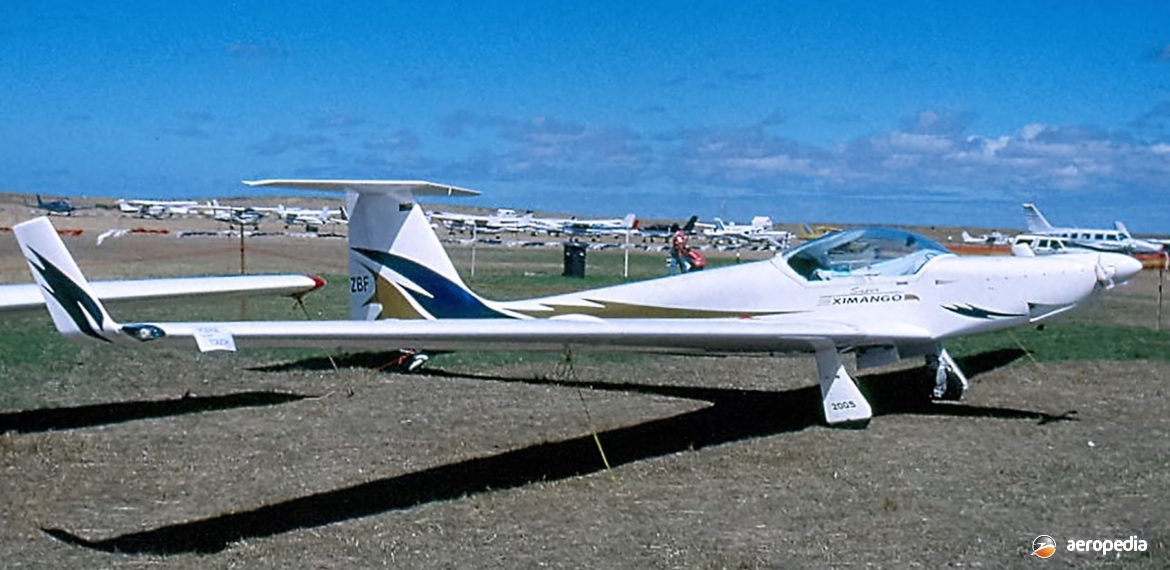Photograph:
Aeromot AMT-200 VH-ZBF (c/n 200.119) at the Australian International Airshow at Avalon, VIC (David C Eyre)
Country of origin:
Brazil
Description:
Two-seat training and sport motor glider
Power Plant:
One 60 kw (80 hp) Rotax 912A four-cylinder horizontally-opposed liquid-and-air-cooled engine
Specifications:
- Wingspan: 17.47 m (57 ft 3¾ in)
- Length: 8.05 m (26 ft 5 in)
- Height: 1.6 m (5 ft 3 in)
- Wing area: 28.7 m² (201.3 sq ft)
- Max cruising speed:205 km/h (127 mph)
- Stalling speed: 72 km/h (45 mph)
- Max rate of climb at sea level: 180 m/min (590 ft/min)
- Service ceiling: 5,000 m (16,400 ft)
- Range with max fuel at 205 km/h (127 mph): 1,220 km (758 miles)
- Empty weight: 605 kg (1,334 lb)
- Useful load: 229 kg (505 lb)
- Loaded weight: 850 kg (1,874 lb)
History:
The Ximango series has been produced by Aeromot Industries Mecamco Metalurgca LTDA in Brazil, which for a time produced the French Fournier RF-10, production rights for which had been obtained in 1985. The French prototype first flew on 6 March 1981 and Brazilian certification of the AMT-100 was granted in June 1986, with French certification in October 1990. The AMT-200, which was developed in Brazil, first flew in July 1992 and was certificated on 3 February 1993, in the US in December 1993 and in the United Kingdom in 1995.
Since then the Company has developed the Ximango in two versions, the AMT-100 Ximango, the initial production version, with a 60 kw (80 hp) Limbach L 2000 EOI four-cylinder engine driving a Hoffman propeller, and the AMT-200 Super Ximango, similar in appearance but having the Rotax 912A engine. It entered production in 1995 and in 1997 some improvements were made. It has been certificated in a number of countries, including Colombia, France, New Zealand and Australia. Customers have included the Brazilian Civil Aeronautical Department.
Variants included aircraft for military/para military roles such as observation, patrol, and counter-insurgency (AMT-100R) and military/police (AMT-100P). An under-fuselage pod for 100 kg (220 lb) of weapons and avionics or surveillance equipment could be fitted. Structure was all GFRP except for a carbon fibre main spar and light alloy brakes. Accommodation was provided for two side-by-side with dual controls.
A development was the AMT-300 Turbo Ximango, which was introduced in 1998 and was fitted with an 86 kw (115 hp) Rotax 914F turbocharged engine, having a re-designed cockpit, new engine cowling and winglets. A further development of the series was the AMT-600 Guri [Little kid], the prototype of which (PP-XBS) was shown at the Brazil International Air Show, Aerosport 2000, which used similar design and construction to the Ximango but was a training aircraft, not a powered glider. It had an 86 kw (115 hp) Lycoming O-235-NBR engine and a fixed tricycle undercarriage. It was aimed at the basic flight training market. A military variant with a 134 kw (180 hp) engine and a retractable undercarriage was also proposed.
A number of AMT-200 Ximangos have been imported to this region, including VH-KIR (c/n 200.068), VH-GFU (c/n 200.056), VH-XJH (c/n 200.077), VH-XNO (c/n 200.129), VH-ZAN (c/n 200.078), VH-ZAO (c/n 200.069), VH-ZBF (c/n 200.129), VH-ZBN (c/n 200.064) and VH-XCQ (c/n 200.163).

